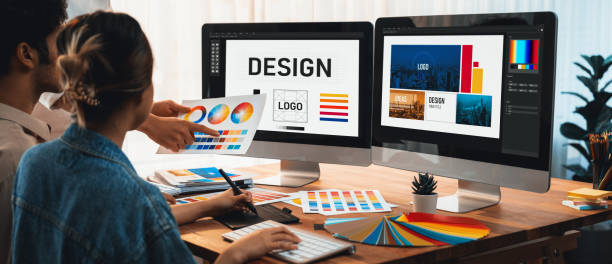Graphic Design: Crafting Visual Narratives in the Digital Age
Graphic design is a powerful medium that shapes perceptions and influences decisions, combining artistry with functionality. It is a powerful tool in the world of visual stimuli, influencing our decisions and communicating complex messages with simplicity and elegance. In this exploration of graphic design, we’ll delve into its foundational principles, its transformative role in the digital realm, and the diverse skill set required for success in this dynamic field.
I. The Essence of Graphic Design
At its essence, graphic design is the art and practice of planning and projecting ideas and experiences with visual and textual content. Graphic designers utilize color theory and other elements in their visual communication to evoke emotions and create visually appealing designs, blending aesthetics with functionality to effectively convey messages and drive user engagement.
II. Foundational Principles of Graphic Design
- Balance: Achieving balance is fundamental in graphic design. Harmonious distribution of visual elements, such as text and images, within a layout can be achieved through symmetrical or asymmetrical balance through contrast and variation.
- Contrast: Contrast is the juxtaposition of different elements to create visual interest and highlight key aspects of a design. This could involve using contrasting colors, fonts, or sizes to draw attention to specific elements and create a dynamic composition.
- Hierarchy: Establishing a visual hierarchy helps guide the viewer’s attention through a design in a deliberate manner. Key information is emphasized, making it easier for the audience to navigate and understand the content.
- Alignment: Consistent alignment of elements creates a sense of order and cohesion in a design. Proper alignment of elements, whether they are aligned to a grid or to each other, significantly improves readability and visual appeal.
- Repetition: Repetition of certain design elements, such as colors, shapes, or patterns, creates consistency and reinforces the overall identity of a brand or project. It helps establish a visual language that is recognizable and memorable.
III. Transformative Role in the Digital Realm
The advent of the digital age has propelled graphic design into new dimensions, expanding its reach and impact. Graphic design plays a crucial role in shaping user experiences on digital platforms, websites, mobile apps, and social media.
- Web Design: Websites are the digital storefronts of the modern era, and web design is a subset of graphic design dedicated to creating visually appealing and user-friendly online interfaces. Web designers focus on layout, navigation, and responsiveness to ensure a seamless and engaging experience for users across devices.
- Social Media Graphics: In the age of social media, where attention spans are fleeting, compelling visuals are paramount. Graphic designers create visually appealing social media graphics for platforms like Instagram, Facebook, and Twitter to enhance brand presence, convey messages, and encourage user interaction.
- User Interface (UI) and User Experience (UX) Design: UI and UX design are integral components of digital product development. UI designers focus on visual elements, aligning with the brand, while UX designers prioritize the overall user experience, including navigation, accessibility, and functionality.
- Motion Graphics: The integration of motion graphics adds a dynamic dimension to static designs. Whether in the form of animated logos, explainer videos, or interactive presentations, motion graphics enhance engagement and bring designs to life.
IV. Diverse Skill Set for Graphic Design Success
- Mastery of Design Software: Proficiency in industry-standard design software such as Adobe Creative Suite (Photoshop, Illustrator, InDesign) is a prerequisite for graphic designers. These tools provide the necessary functionalities for creating and manipulating visual elements.
- Typography Expertise: Typography is a cornerstone of graphic design. Understanding fonts, spacing, and hierarchy is crucial for creating visually appealing, legible, and effective designs that effectively convey the intended message.
- Color Theory Knowledge: Colors evoke emotions and convey meanings. Graphic designers need a solid understanding of color theory to choose palettes that align with the message and brand identity. This involves understanding the psychology of different hues, their complementary effects, and the psychological effects of different colors.
- Creativity and Conceptual Thinking: Graphic design is inherently a creative field. The ability to think conceptually, generate unique ideas, and translate them into visually compelling designs sets successful graphic designers apart. Creativity is the driving force behind memorable and impactful visuals.
- Communication Skills: Graphic designers often collaborate with clients, marketing teams, and other stakeholders. Effective communication is crucial for comprehending client needs, effectively conveying design concepts, and incorporating constructive feedback.
- Observation of Detail: Observation of detail is crucial in graphic design, ensuring alignment, fine-tuning color schemes, and refining typography to enhance the final product’s quality.
V. The Future of Graphic Design
The future of graphic design is promising due to the advancements in technology. Augmented reality (AR) and virtual reality (VR) are emerging as innovative mediums for graphic designers to explore, offering immersive and interactive experiences. The integration of AI could potentially automate certain design processes, enabling designers to concentrate on more creative aspects.
Furthermore, environmental sustainability is becoming a focal point in design practices. Graphic designers are increasingly incorporating eco-friendly principles, such as using sustainable materials and reducing waste, to contribute to a more environmentally conscious industry.
VI. Conclusion
Graphic design, in its evolution from traditional print to the expansive digital landscape, remains a cornerstone of visual communication. Its principles of balance, contrast, hierarchy, alignment, and repetition continue to guide designers in creating impactful visuals. The fusion of artistic expression with technological advancements has positioned graphic design as a dynamic and indispensable force shaping the way we perceive and interact with the world. In a society where visuals speak volumes, the role of graphic design is not just to decorate but to narrate compelling stories that resonate across diverse audiences.






[…] of freelance writing positions it as an ideal profession for remote work. With the growth of online communication tools and collaboration platforms, freelance writers can seamlessly collaborate with clients and […]
[…] Graphic Design: Logo design, brand identity, web design, graphic illustrations, marketing materials. […]